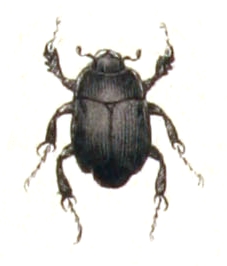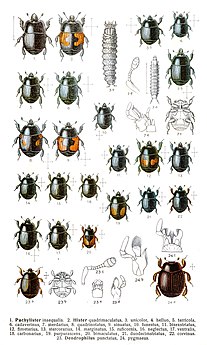Eremosaprinus is a genus of clown beetles in the family Histeridae. There are about 10 described species in Eremosaprinus.
Hololepta lucida is a species of clown beetle in the family Histeridae. It is found in North America.
Chaetabraeus chandleri is a species of clown beetle in the family Histeridae. It is found in North America.
Hister curtatus is a species of clown beetle in the family Histeridae. It is found in North America.
Omalodes is a genus of clown beetles in the family Histeridae. There are at least 60 described species in Omalodes.
Omalodini is a tribe of clown beetles in the family Histeridae. There are at least 2 genera and 60 described species in Omalodini.
Teretriosoma is a genus of clown beetles in the family Histeridae. There are about nine described species in Teretriosoma.
Hister coenosus is a species of clown beetle in the family Histeridae. It is found in the Caribbean, Central America, and North America.
Strigister is a genus of clown beetles in the family Histeridae. There are at least two described species in Strigister.
Paromalus debilis is a species of clown beetle in the family Histeridae. It is found in North America.
Pinaxister is a genus of clown beetles in the family Histeridae. There are at least four described species in Pinaxister.
Hololepta yucateca is a species of clown beetle in the family Histeridae. It is found in Central America and North America.
Iliotona is a genus of clown beetles in the family Histeridae. There are about five described species in Iliotona.
Pseudepierus gentilis is a species of clown beetle in the family Histeridae. It is found in North America.
Pseudepierus is a genus of clown beetles in the family Histeridae. There are at least two described species in Pseudepierus.

Dendrophilus is a genus of clown beetles in the family Histeridae. There are about 11 described species in Dendrophilus.

Dendrophilus punctatus is a species of clown beetle in the family Histeridae. It is found in Europe & Northern Asia and North America.
Yarmister barberi is a species of clown beetle in the family Histeridae. It is found in North America.
Yarmister is a genus of clown beetles in the family Histeridae. There are at least two described species in Yarmister.
Merohister osculatus is a species of clown beetle in the family Histeridae. It is found in North America.



